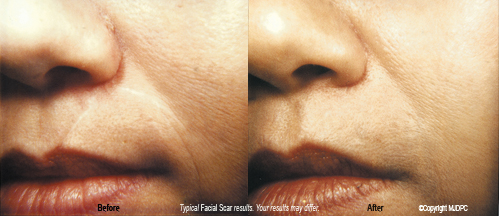Scar and Stretch Mark Removal
Unsightly scars and stretch marks, or striae, have presented problems for men and women for centuries. Scars and stretch marks are generally considered unsightly, disfiguring and unacceptable by many people.

What causes scars & stretch marks?
Scars form as part of the skin's healing process whenever multiple layers of skin are injured. The injury may be the result of an accident, surgery, a burn or even severe acne.
While the exact cause of stretch marks is unknown, it is thought that striae are the result of your skin's collagen and elastin breaking down under stress. Pregnancy, body building and weight loss are the leading causes of stretch marks. Stretch marks occur most frequently in areas of mechanical stress such as the breasts, abdomen, thighs, groin or buttocks. In the beginning, stretch marks are red. They turn white as part of the healing process.
In the past, cryosurgery (freezing), excision, steroid injections and the use of topical creams and ointments were the standard of care for the treatment of scars and stretch marks. The results of these treatments range from fair to minimal, with recurrences commonly seen after many of these treatment options.

Laser Technology for scars and stretch marks
Today, laser treatments to treat a wide variety of scars and stretch marks are performed by our doctor for patients in our region.
The laser's energy stimulates the skin under the scar and causes the fibroblasts in the skin to begin to divide again. It also stimulates the production of collagen. This thickens the skin under the scar until it closely resembles the surrounding normal skin.
Do laser treatments for scars and stretch marks work?
Our current laser technology has been shown to improve or eliminate red or raised scars. Recent studies have demonstrated that laser treatments stimulate the production of collagen and improve or eliminate the appearance of stretch marks.
Additional studies show that the appearance of stretch marks continues to improve over a period of time ranging from 3 - 6 months after the laser treatment was given. Even those treatments that showed little if any initial improvement showed as much as a 50% improvement at their 6-month checkup.
Who are the best candidates for laser scar and stretch mark removal?
The patients that respond the best to laser treatment for scars and stretch marks are those with:
- Fair complexion and light pigmentation
- Shallow scars or stretch marks
Note: Patients with a history of Vitiligo, pigmentation disorders, dark tans or dark pigmentation may require an initial skin test for evaluation by our physician prior to treatment.
What else can be used to treat scars?
Scarfade™ and Laserfade™ are silicone gels that when applied to the skin form a micro-thin layer of silicone on the scar. They can be worn under cosmetics and are both easily tolerated by children. The silicone is thought to moisturize the skin, reduce capillary irritation and allow the skin to return to its normal texture and color.

Do laser scar and stretch mark treatments hurt?
Most patients do not require anesthetic. Some patients have indicated that they feel a slight tingling when the laser pulses, or that the laser pulse feels like the snap of a rubber band against the skin.
What should you expect after laser treatment for scars and stretch marks?
After our doctor performs a laser treatment, results vary from patient to patient and may not be immediate. Results from laser scar and stretch mark treatment are generally progressive and may require multiple treatments. If you respond to the first treatment, your second treatment will usually be as good as the first, and the third treatment will be almost as good. About 70% of patients receiving laser treatments for their stretch marks notice a marked improvement. Newer and shallower stretch marks and scars respond better than older and deeper scars and stretch marks. To enhance the results of your laser treatments your surgeon may recommend the use of tretinoin cream or a glycolic acid cream prior to and after your laser treatments.